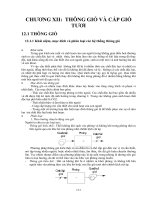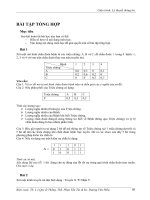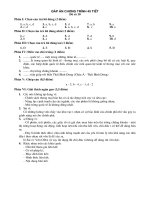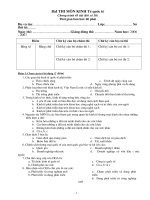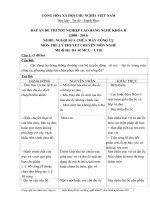speaking-unit 12-english 10
Bạn đang xem bản rút gọn của tài liệu. Xem và tải ngay bản đầy đủ của tài liệu tại đây (163.83 KB, 7 trang )
LESSON PLAN
Tieng Anh 10 (Basic)
Unit 12: MUSIC
Lesson 2: SPEAKING
LESSON PLAN
Tieng Anh 10 (Basic)
Unit 12: MUSIC
Lesson 2: SPEAKING
Objectives:
1. Education aims: - Students know about some favorite kinds of music.
2. Knowledge:
a. General knowledge: - Students can talk about their favorite kinds of music.
b. Language: - The simple present tense.
- Vocabulary about music.
3. Skills: - Asking and answering questions about music.
- Talking about favorite kinds of music
Materials:
Textbook, pictures, handouts, computer
Anticipated problems:
Ss may not have enough vocabulary to talk about the topic, so T should be ready to
provide help.
Procedure:
Time Steps Work
arrangement
5m WARM UP: Game: ”Lucky number”
Instruction: You are going to take part in a game
called “Lucky number”. You will hear some songs and
answer the question “What kind of music do these songs
belong to?”
- T divides the class into two teams (A and B).
- T shows the poster of eight numbers on the BB.
Among them, there are two lucky numbers.
- Each team will in turn choose a number corresponding
to one question.
- If team A takes their turn and give the correct answer,
they will get two marks, but if team A gives the
incorrect answer, they will lose their turn and team B
will have the right to answer and get one mark if they
have the correct answer.
Group work
1m
4m
- If any team chooses a lucky number, that team will
have two marks without answering.
- After finishing, the team with more marks will be the
winner.
Checking instruction:
1. How many numbers are there?
2. Do you choose a number first? And next?
3. If another team cannot answer the question in their
turn, how many marks will you get if you have the
correct answer?
4. Good! And which team will be the winner?
- Now, let’s start.
Answers:
SONGS KINDS OF MUSIC
1. In My Head
2. Anyone of us
3. Đi cấy
4. Em đi mẫu giáo
5. Ra khơi
6. The music lovers
Dance music
Pop music
Folk music
Children music
Rock music
Classical music
- Lucky numbers: numbers 1 and 2
Lead in:
- How do you feel now?
Expected answer: very interesting
- Do you like music?
Expected answer: yes
- Good! Today, we will talk about music taste.
I. PRE-SPEAKING:
a. Teaching vocabulary:
+ favorite (adj): được ưa thích, ưa chuộng
- T elicits a new word by explanation technique:
I love rock music, it is very noisy. I feel happy and
comfortable when I listen to rock music. The rock music
is my……kind of music.
- T reads out it before the whole class.
- T asks Ss to repeat it chorally and individually.
- T writes the new word on BB.
- T asks Ss to give meaning of the new word.
- T asks Ss to gives stress of the new word.
- And finally, T gives Ss the correct stress of the new
T-The whole class
T-The whole class
2m
10m
word.
+ piece of music (n.phr): bản nhạc
- T elicits a new word by showing a picture and asking
Ss “What’s this?”
- T reads out it before the whole class.
- T asks Ss to repeat it chorally and individually.
- T writes the new word on BB.
- T asks Ss to give meaning of the new word.
- T asks Ss to gives stress of the new word.
- And finally, T gives Ss the correct stress of the new
word.
+ relaxed (adj): thoải mái, thư giản
- T elicits a new word by Mime technique:
T turns on a piece of music and mines feeling relaxed,
and then asks “How do I feel now?”
- T reads out it before the whole class.
- T asks Ss to repeat it chorally and individually.
- T writes the new word on BB.
- T asks Ss to give meaning of the new word.
- T asks Ss to gives stress of the new word.
- And finally, T gives Ss the correct stress of the new
word.
b. Checking vocabulary: Rub out and remember.
- T reads and asks Ss to repeat word by word again.
- T then rubs out English words one by one, leave
Vietnamese versions left on the board.
- T points to a Vietnamese version and asks Ss to speak
out that word in English (Chorally & Individually).
- T asks one Ss to go to the board and rewrite all the
English words.
II. WHILE-SPEAKING:
1. Activity 1: Interview
- T asks Ss to work in pairs: one asks and the other
answers to fill the information in the table.
- Ss change their role to get information to finish the
table.
- T gives Ss handouts as follow:
Partner 1 Partner 2
kind of music classical music
reasons for
listening to music
favorite band /
T-The whole class
Pair work
10m
musician / singer
favorite song /
piece of music
when listen to
music
some adjectives and expressions to talk about music
+ make sb excited:làm ai đó vui vẽ
+ make sb feel relaxed: làm ai đó cảm thấy thoải mái
+ help sb forget troubles and worries: giúp ai đó quên
đi những vấn đề hay nổi lo lắng
+ peaceful (a): yên bình
+ joyful (a): yêu thích
+ Interesting (a): thú vị…….
* Checking instructions:
1. Will we work in pairs or groups?
( Ss: work in pairs)
2. What is each person’s role?
(Ss: one asks. The other answers)
3. Can you change your role?
(Ss: yes)
* Suggested questions:
1. What kind of music do you like?
2. Why do you like it?
3. Who is your favorite band/musician/singer?
4. What is your favorite song/piece of music?
5. When do you listen to music?
- T can model with 1 good student:
E.g.: T: Hello! My name’s Linh
S: Hello! My name’s Hoa
T: May I ask you some questions about your music
taste?
S: Yes, of course!
T: What kinds of music do you like best?
S: I like pop music best
T: Why do you like it?
S: I like it because……
………………………………
- T asks Ss to start interviewing.
- T goes around to observe, offer help and collect
mistakes and errors for later correction.
- T calls on some pairs to present in front of the class
- T gives the feedback.
2. Activity 2: Reporting on the information
- T asks Ss to report about what they had in the
interview of 2
nd
activity in While-stage.
Individual work
10m
3m
- Before Ss report, T elicits the structures they can use:
The same interest The different interest
+ Both I and He/She
like….
+ I like…, and so does
He/She
+ I like …, and He/She
does, too
……………
+ I like…, but He/She
likes/prefers…
+ I like…, but He/She
doesn’t…
…………………
- T gives SS some examples:
Both I and He/She like pop music. We like it because…
Or I like pop music, but He/She prefers classical music.
- T asks Ss to prepare in 3 minutes.
- T goes around to give help if necessary.
- T calls on some Ss to report what they have found out
about their partners in front of the class.
- T gives the feedback.
III. POST-SPEAKING
Activity 3: Talk about the music taste.
- T gives Ss a model as follow:
“Yes, I love pop music. It keeps me happy. I really like
the Backstreet Boys – they are easy to listen to. Their
songs cheer me up whenever I feel bad. I listen to them
all the time. I’ve got a Walkman so I can listen to music
when I’m out. At home I always have the radio on and I
watch pop programmes on TV.”
- T lets Ss to read it in 2 minutes.
- T asks Ss to work in pairs, basing on the model to talk
about your own music taste in 3 minutes.
- T moves around to give help if necessary.
- T calls on some Ss to present before the whole class
- T gives feedback.
V. EVALUATION-HOMEWORK:
EVALUATION:
- T asks the whole class to give any questions for the
lesson today.
- T calls on some Ss to give comments of the lesson.
- And finally, T gives comments of the lesson.
Pair work
T-The whole class
HOMEWORK:
T asks Ss to rewrite the activity 3 in a short paragraph.



